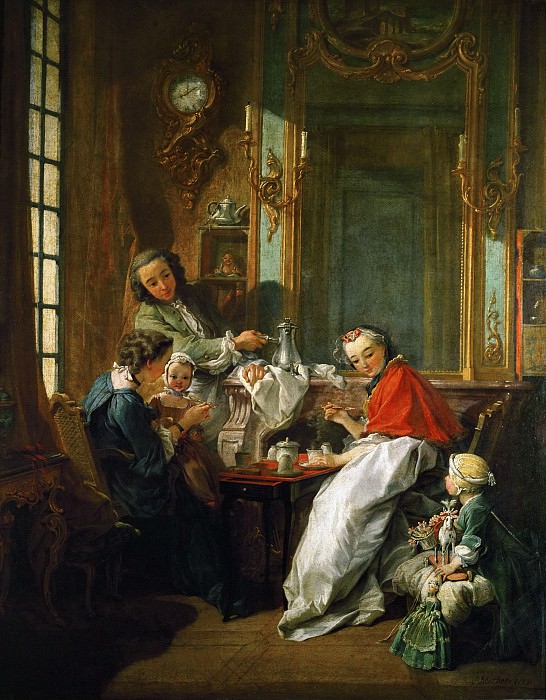Morning Coffee Francois Boucher (1703-1770)
Francois Boucher – Morning Coffee
Edit attribution
Download full size: 2282×2928 px (1,6 Mb)
Painter: Francois Boucher
François Boucher was considered the king’s court painter during the reign of Louis XV. He became famous not only as a talented painter, but also as a decorator. Boucher painted landscapes, portraits, and pastorals, capturing biblical and mythological subjects on his canvases. The pearl of the famous painter’s collection is Breakfast. Here the author is said to have represented his family, or perhaps the ideal of his family.
Description of the painting "Breakfast" by François Boucher
François Boucher was considered the king’s court painter during the reign of Louis XV. He became famous not only as a talented painter, but also as a decorator. Boucher painted landscapes, portraits, and pastorals, capturing biblical and mythological subjects on his canvases.
The pearl of the famous painter’s collection is Breakfast. Here the author is said to have represented his family, or perhaps the ideal of his family. He depicts himself, his beloved, his children and his nanny at a meal. The faces of the adults and children are happy, and there is family and comfort in the room.
The painting conveys the warmth of the relationship between the members of a large family, well-being, joy, love: this is evidenced by the color scheme. Shades range from dark to gently warm, immersing the viewer in the atmosphere of everyday life of those years. This work, among other things, demonstrated Boucher’s design skills. The artist carefully and in detail painted all the details of the interior: a huge gilded mirror, antique wall clocks, graceful twisted legs of the table, beautiful service, decorative figures on shelves, children’s toys. But especially chic are the clothes of the characters depicted on the canvas.
Little girls are dressed in tiny lush lace dresses and bonnets. And the women show a sense of style and taste: even the nurse is dressed up especially elegantly.
The artist worked on every detail, making it not only beautiful, but meaningful. The doll standing at the girl’s feet, the furniture, the objects on the tables and on the shelves. For example, the Buddha standing on a bookstand speaks to the popularity of Chinese art in those days.
The work allows not only to feel a happy moment, so vividly remembered by the author, but also to learn about the way of life of those years, the spirit of the era and a certain luxury, so skillfully conveyed by the genius creator.
Кому понравилось
Пожалуйста, подождите
На эту операцию может потребоваться несколько секунд.
Информация появится в новом окне,
если открытие новых окон не запрещено в настройках вашего браузера.
You need to login
Для работы с коллекциями – пожалуйста, войдите в аккаунт (open in new window).




















You cannot comment Why?
In the painting Morning Coffee, a group of individuals is gathered in a richly decorated interior, bathed in gentle morning light streaming from a large window on the left. The scene depicts a moment of leisure and domesticity, likely from the Rococo period, given the ornate furnishings and pastel color palette.
At the center, a man in a light green jacket is pouring a drink from a silver pitcher into a cup held by a woman in a vibrant red cape and a flowing white dress. To their left, a woman in a dark blue dress is seated, holding a baby who is being offered something from a spoon. A young girl, dressed in a green outfit and a bonnet, sits on the floor to the right, engrossed in a collection of toys and a fan, suggesting a playful element within the domestic refinement.
The room is adorned with gilded frames, ornate wall sconces with lit candles, a decorative clock, and a large mirror that reflects the scene and the architecture of the room, adding depth and a sense of spaciousness. A small table between the central figures holds a tea set, reinforcing the theme of a morning beverage ritual.
The subtexts of the painting explore themes of aristocratic leisure and domestic intimacy. The leisurely act of sharing coffee or tea in a well-appointed room signifies the comfortable lifestyle of the upper class. The presence of the baby and the young child highlights the importance of family and the continuation of lineage within this setting. The painting also subtly conveys a sense of serenity and contentment, with the soft lighting and the calm interactions between the figures. The focus on beautiful attire and elegant surroundings underscores the aesthetic sensibilities of the time, where beauty and refinement were highly valued. The scene appears almost theatrical, inviting the viewer to observe a private moment of familial warmth and social grace.